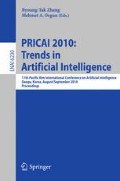Abstract
“The only thing constant is change.”—Ray Kroc (Founder of McDonald’s). Self-organizing neuro-fuzzy machines are maturing in their online learning process for time-invariant conditions. To, however, maximize the operative value of these self-organizing approaches for online-reasoning, such self-sustaining mechanisms must embed capabilities that aid the reorganizing of knowledge structures in real-time dynamic environments. Also, neuro-fuzzy machines are well-regarded as approximate reasoning tools because of their strong tolerance to imprecision and handling of uncertainty. Recently, Tan and Quek (2010) discussed an online self-reorganizing neuro-fuzzy approach called SeroFAM for financial time-series forecasting. The approach is based on the BCM theory of neurological learning via metaplasticity principles (Bienenstock et al., 1982), which addresses the stability limitations imposed by the monotonic behavior in Hebbian theory for online learning (Rochester et al., 1956). In this paper, we examine an adapted version called iSeroFAM for interval-forecasting of financial time-series that follows a computational efficient approach adapted from Lalla et al. (2008) and Carlsson and Fuller (2001). An experimental proof-of-concept is presented for interval-forecasting of 80 years of Dow Jones Industrial Average Index, and the preliminary findings are encouraging.
Access this chapter
Tax calculation will be finalised at checkout
Purchases are for personal use only
Preview
Unable to display preview. Download preview PDF.
References
Abraham, W.C., Goddard, G.V.: Asymmetric relationships between homosynaptic long-term potentiation and heterosynaptic depression. Nature 305, 717–719 (1983)
Angelov, P.P., Filev, D.P.: An approach to online identification of Takagi-Sugeno fuzzy models. IEEE Trans. Syst. Man Cybern. B 34(1), 484–498 (2004)
Angelov, P.P., Filev, D.P.: Simpl_eTS: a simplified method for learning evolving Takagi-Sugeno fuzzy models. In: Proc. 14th IEEE Int. Conf. Fuzzy Syst., FUZZ-IEEE 2005, Reno, NV, pp. 1068–1073 (2005)
Bienenstock, E.L., Cooper, L.N., Munro, P.W.: A theory for the development of neuron selectivity: orientation specificity and binocular interaction in visual cortex. J. Neurosci. 2, 32–48 (1982)
Bliss, T.V.P., Lømo, T.: Long-lasting potentiation of synaptic transmission in the dentate area of the anaesthetized rabbit following stimulation of the perforant path. J. Physiol. 232, 331–356 (1973)
Carlsson, C., Fullér, R.: On possibilistic mean value and variance of fuzzy numbers. Fuzzy Sets Syst. 122(2), 315–326 (2001)
Cooper, L.N., Intrator, N., Blais, B.S., Shouval, H.Z.: Theory of Cortical Plasticity. World Scientific, Singapore (2004)
Goodwin, G.C., Sin, K.S.: Adaptive Filtering: Prediction and Control. Prentice-Hall, Englewood Cliffs (1984)
Haykin, S.: Adaptive Filter Theory. Prentice-Hall, Englewood Cliffs (1996)
Jang, J.S.R.: ANFIS: adaptive-network-based fuzzy inference system. IEEE Trans. Syst. Man Cybern. 23(3), 665–685 (1993)
Jang, J.S.R., Sun, C.T., Mizutani, E.: Neuro-Fuzzy and Soft Computing. Prentice Hall, Upper Saddle River (1997)
Kasabov, N.K.: Evolving fuzzy neural networks for supervised/unsupervised online knowledge-based learning. IEEE Trans. Syst. Man Cybern. B 31(6), 902–918 (2001)
Kasabov, N.K., Song, Q.: DENFIS: dynamic evolving neural-fuzzy inference system and its application for time-series prediction. IEEE Trans. Fuzzy Syst. 10(2), 144–154 (2002)
Lalla, M., Facchinetti, G., Mastroleo, G.: Vagueness evaluation of the crisp output in a fuzzy inference system. Fuzzy Sets Syst. (2008) (in Press)
Leng, G., Prasad, G., McGinnity, T.M.: An on-line algorithm for creating self-organizing fuzzy neural networks. Neural Netw. 17, 1477–1493 (2004)
Lin, C.T., Lee, C.S.G.: Neural Fuzzy Systems: A Neuro-Fuzzy Synergism to Intelligent Systems. Prentice Halls, Upper Saddle River (1996)
Mitra, S., Hayashi, Y.: Neuro-fuzzy rule generation: survey in soft computing framework. IEEE Trans. Neural Netw. 11(3), 748–768 (2000)
Rochester, N., Holland, J., Haibt, L., Duda, W.: Tests on a cell assembly theory of the action of the brain, using a large scale digital computer. IRE Trans. Inf. Theory IT-2, 80–93 (1956)
Rong, H.J., Sundararajan, N., Huang, G.B., Saratchandran, P.: Sequential adaptive fuzzy inference system (SAFIS) for nonlinear system identification and prediction. Fuzzy Sets Syst. 157, 1260–1275 (2006)
Stanton, P.K., Sejnowski, T.J.: Associative long-term depression in the hippocampus induced by Hebbian covariance. Nature 339, 215–218 (1989)
Tan, J., Quek, C.: Adaptive training schema in Mamdani-type neuro-fuzzy models for data-analysis in dynamic system forecasting. In: Liu, D. (ed.) Proc. 2008 Int. Joint Conf. Neural Netw., IJCNN 2008, HongKong, pp. 1734–1739 (2008)
Tan, J., Quek, C.: A BCM-theory of meta-plasticity for online self-reorganizing fuzzy-associative learning. IEEE Trans. Neural Netw. 21(6), 985–1003 (2010)
Tickle, A.B., Andrews, R., Golea, M., Diederich, J.: The truth will come to light: directions and challenges in extracting the knowledge embedded within trained artificial neural networks. IEEE Trans. Neural Netw. 9(6), 1057–1068 (1998)
Wang, W., Vrbanek, J.: A multi-step predictor for dynamic system property forecasting. Measurement Sci. Technol. 18(12), 3673–3681 (2007)
Watts, M.J.: A decade of Kasabov’s evolving connectionist systems: a review. IEEE Trans. Syst. Man Cybern. C, Appl. Rev. 39(3), 253–269 (2009)
Wu, S., Er, M.J.: Dynamic fuzzy neural networks: a novel approach to function approximation. IEEE Trans. Syst. Man Cybern. B 30(2), 358–364 (2000)
Zadeh, L.A.: Soft computing and fuzzy logic. IEEE Softw. 11(6), 48–56 (1994)
Author information
Authors and Affiliations
Editor information
Editors and Affiliations
Rights and permissions
Copyright information
© 2010 Springer-Verlag Berlin Heidelberg
About this paper
Cite this paper
Tan, J., Quek, C. (2010). Online Self-reorganizing Neuro-fuzzy Reasoning in Interval-Forecasting for Financial Time-Series. In: Zhang, BT., Orgun, M.A. (eds) PRICAI 2010: Trends in Artificial Intelligence. PRICAI 2010. Lecture Notes in Computer Science(), vol 6230. Springer, Berlin, Heidelberg. https://doi.org/10.1007/978-3-642-15246-7_48
Download citation
DOI: https://doi.org/10.1007/978-3-642-15246-7_48
Publisher Name: Springer, Berlin, Heidelberg
Print ISBN: 978-3-642-15245-0
Online ISBN: 978-3-642-15246-7
eBook Packages: Computer ScienceComputer Science (R0)

